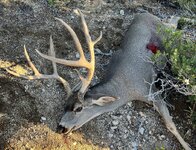Blue x and Red x both have good potential for quick death with a well constructed bullet flying fast enough. For me this shot would depend on distance and wind speed/direction for whether I’d favor a red x or blue x.
I think people fail to realize that every animal is different just like every human is different. I’ve seen hearts completely blown out of deer and elk and they proceed to run 80-100 yards. I’ve seen deer and elk shot in the guts, drop and die instantly.
Until you open an animal up and see what happened it’s all speculation. Predicting wild animal behavior based on limited information will have you scratching your head most of the time.
OP I appreciate these videos. Would be really cool to be able to do a “collage” of photos following the videos of the shots.


